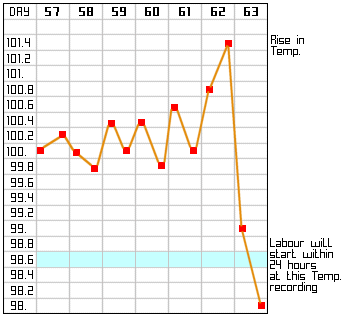|
 Helping your dog with
labour and delivery Helping your dog with
labour and delivery
Helping to bring newborn puppies into the world can be a thrilling experience. Unfortunately, your dog can't always tell you when things aren't going as smoothly as planned. While it's your dog that will still do most of the work, there are some simple measures you can take to ensure that all goes smoothly during
labour and delivery and there are no major complications.
The Basics about Canine Pregnancy
Dogs generally give birth 58-68 days after conception. It's always a good idea to have a veterinarian check over your pup during pregnancy, just to be sure she's eating enough, getting all the nutrients her growing body requires, and there are no obvious complications. You'll know your dog is nearing the birthing time when her appetite increases and her need for playtime and attention decreases. During this time, she may begin hiding in various areas of the house, trying to nest.
The Making of a Maternity Ward
Most dogs will decide on their own where they're most comfortable giving birth. Pets seem to
favour enclosed areas that are void of noise, distraction and foot traffic.
Favourites include closets, stairwells, and behind objects. If this is conducive to your lifestyle, by all means, let her go where she's comfortable. If not, it's okay to set up a Maternity Ward of your own.
A kiddy sized swimming pool makes an excellent birthing space. The pool will be easy to clean and will also prevent the newborn pups from tipping out. Line the
kiddy pool with old sheets or fresh towels and newspapers that you can quickly throw away and or replace during
labour and delivery. Boxes also make excellent spaces for giving birth. Experts use what's called a
"whelping box," which is nothing more than a box in which the dog will have adequate privacy. You can make your own box at home with a cardboard oven or refrigerator box. The box you use should be large enough for mom to stretch out and still leave enough space for small pups. One side should be low enough for the mother to crawl in and out of, but high enough to prevent the puppies from doing so. Whatever you decide to use, try to acquaint your pet with her maternity ward early so she'll be more likely to feel comfortable there when the time comes.
Make Her Comfortable
Line your box or pool with as many towels or sheets that you can find. Remember, your dog has a long night ahead of her. Tossing in her
favourite toy or blanket will encourage your pet to use her whelping box. Making your dog comfortable during this time should be your top priority.
Keep the Noise Down
Your dog will want some privacy on the big day. Loud noises, company and constant interruptions will only make your dog nervous. As much as small children (and even adults) would like to experience the delivery, try and keep human contact to a minimum.
Is it Time?
Approximately 6-24 hours before giving birth, your dog may begin shivering, pacing, panting or acting out of character. She may trot around nervously or claw at the floor, looking for a place to nest. If your animal does begin to nest elsewhere and refuses to use her whelping box, let her go. Provide fresh bedding and newspapers where she is and move the whelping box close to her. As the puppies are born, you can move them into the box, which will encourage mom to follow.
*Taking your dogs temperature and recording it will tell you, within 24 hours, when
labour will begin.
Did you also know that 12-24 hours before it drops it will rise higher then
it's been in weeks.
This gives you more time to prepare for the birth of her puppies.
1. Begin taking your dog's temperature at your estimated day 56 of her cycle.
2. Record it in the Am and PM ( best time is when the dog is calm).
3. Don't miss taking a temp
You will notice a huge increase in temperature right before it drops. Any temperature recorded lower than 98.4 indicates
labour should begin within 24 hours. If your dog goes beyond 24 hours and labour
has not
begun, call your veterinarian.
Why should you take an record your bitches temperature.?
So you can know within 24 hours, when your dog will go into labour.
A dogs normal Temperature is 101.5.
In the last trimester of pregnancy the pregnant bitch will have a temperature around 100. This is contributed to hormone levels.
Dogs can safely whelp their litters 58 days after conception. After 58 days the pups lungs are fully developed and they can breath on their own.
Not all thermometers are created equal. Do not use tape on the forehead thermometer or in the ear thermometers, and please don't use the under the arm pit method. If you don't know how to read a thermometer ask a
pharmacist or a friend. I find the most accurate thermometers to be the glass rectal thermometer. If you feel your dog is hyper and glass can pose a danger, than use the digital thermometer. Always use the same thermometer, don't switch back and forth, or you will not get accurate readings.
Take your dog's temperature in the morning and in the evening. The best time to get an accurate reading is when your dog has been sleeping or is calm , not after a run in the yard or playtime.
How to take your dog's temperature
Began with shaking the thermometer below 98 degrees.
Stick it in a jar of clean petroleum jelly. In an emergency I have use cooking oil or spit.
Shaking it down before applying a lubricant (may avoid Vaseline gobs on the walls or in your hair or Aunt Edna's picture above the
fireplace).
Make your dog lay down and do not let the dog sit down and break the thermometer while it is inserted in her rectum. Hold on to the thermometer so you don't lose it. Inset the thermometer in 2 inches, rotate or spin if you
feel resistance. Your goal is to take the dogs temperature, not a chunk of faeces.
Keep the thermometer in for 2 minutes.
Take out and wipe it with a tissue.
Read it, and record the temperature on your chart..
There are many signs to let you know when the time is near.
-
Temperature has dropped between 99. to 98. degrees.
-
Pupils will dilate.
-
She will hide in dark places.
-
Digging
-
Panting
-
She will stare at her rear end in confusion.
Soon your dog will learn what a thermometer is and will bolt the second it
sees you coming. This may be a wonderful preventive measure to stop your dog from jumping on people.
(*Extracted from Debbie Jensen's "Predicting
Whelping Day")

st
A note about emergencies:
Most births go smoothly. There are occasions, however, during which the mother may need help. Watch for these danger signs and act immediately, if necessary:
-
Your dog passes dark green fluid before delivery.
-
Your dog has been straining (without delivering) for more than one hour.
-
Your dog is weak, restless and nervous for more than thirty minutes after labour
stops.
-
Your dog begins shaking, trembling or begins vomiting days or weeks after delivery.
Should your pet exhibit any of these symptoms, contact your veterinarian immediately. These are emergency symptoms and time is of the essence.
The Birth
Dogs generally take care of themselves during birthing and delivery, and there is rarely a cause for human intervention. There are a few instances however, when you may need to act as midwife for your friend. Follow these guidelines for a safe delivery:
1. If a puppy seems to only come out half way, despite extensive straining by it's mother, you'll need to jump in and assist. Have someone hold your pet's head and gently grab the puppy with a clean towel and pull firmly. If the puppy doesn't immediately slide out, call your veterinarian immediately.
2. The mother will get more and more tired during large litters. Though dogs instinctively tear off the amniotic sac and bite the umbilical cord off, your dog may be too weak or tired by the end of delivery to do so. If you find that a puppy has not been cared for after delivery, remove the amniotic sac by peeling it from the puppy. Start at the baby's mouth and work toward it's tail. You can clean the mucus from it's mouth with your finger. Also, be sure to vigorously rub the puppy for several seconds with a clean towel. This will keep the puppy's heart beating and help to integrate him in the outside world. If need be, you can cut the umbilical cord yourself with a sterile scissor or tie it off with sewing thread.
The Aftermath
Now that your dog has given birth, you have a whole new family to watch over. Remember, your dog will be protective of her new pups, so for at least the first few hours, keep traffic to a minimum. Your dog may also not want to leave her whelping box after birth. Let her actions guide your
behaviour, but also make sure she has an adequate supply of water and food and is allowed outdoors to relieve herself whenever needed. It's helpful to place the dog's food and water close to the whelping box, so she feels comfortable enough to care for herself.

| LINKS
TO RELATED ARTICLES |
|
|
|
|
| |
|
|


|
|
 Helping your dog with
labour and delivery
Helping your dog with
labour and delivery


